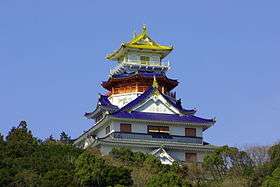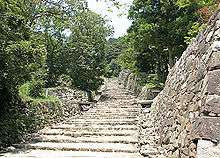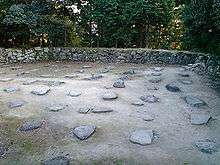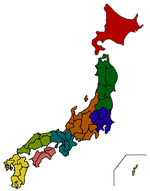Azuchi Castle
| Azuchi Castle 安土城 | |
|---|---|
| Azuchi, Ōmi province, Japan | |
 Reproduction of Azuchi's main keep, at Ise Azuchi-Momoyama Bunka Mura | |
| Type | Azuchi-Momoyama castle |
| Height | Seven stories (138ft)(main keep) |
| Site information | |
| Controlled by | Oda Nobunaga |
| Condition | Stone base remains |
| Site history | |
| Built | 1579 |
| Built by | Oda Nobunaga |
| Materials | stone, wood, plaster walls |
| Demolished | 1582, by Akechi Mitsuhide |
| Events | Azuchi religious debate (1579) |
| Garrison information | |
| Garrison | 5,000 (incl. civilians) |



Azuchi Castle (安土城 Azuchi-jō) was one of the primary castles of Oda Nobunaga. It was built from 1576 to 1579, on the shores of Lake Biwa, in Ōmi Province.[1] Nobunaga intentionally built it close enough to Kyoto that he could watch over and guard the approaches to the capital, but, being outside the city, his fortress would be immune to the fires and conflicts that occasionally consumed the capital. This location was also quite strategically advantageous in managing the communications and transportation routes between his greatest foes - the Uesugi clan to the north, the Takeda clan in the east, and the Mōri clan to the west.[2]
History
Niwa Nagahide had responsibility for constructing the castle, which began in 1576 and completed in 1579.[3][4]:289,301
Unlike earlier castles and fortresses, Azuchi was not intended to be a military structure alone, cold, dark, and foreboding. Nobunaga intended it as a mansion which would impress and intimidate his rivals not only with its defenses, but also with its lavish apartments and decorations, flourishing town, and religious life. The keep, called tenshu (or tenshukaku), rather than being the center of the castle's defences, was a seven-story building containing audience halls, private chambers, offices, and a treasury, as though it were a royal palace. All seven storeys were decorated by Kanō Eitoku.[4]:380-381
In addition to being one of the first Japanese castles with a tower keep, Azuchi was unique in that its uppermost story was octagonal. In addition, the facade of Azuchi, unlike the solid white or black of other castles, was colorfully decorated with tigers and dragons.
There were five main militaristic features of Azuchi Castle that differentiated it from earlier castle designs. Firstly, it was a massive structure, with the walls of the castle ranging from 18 feet to 21 feet in thickness. The second feature of Azuchi Castle is the predominant use of stone. The walls were constructed from huge granite stones fitted carefully together without the use of mortar. A third innovation of the Azuchi Castle was the high central tower, or donjon. The tower allowed for increased visibility for the use of guns against an opposing force. Builder’s plans for the castle show the donjon to be 138 feet tall, with seven levels. Fourthly, Azuchi Castle had irregularly formed inner citadels. These inner citadels gave defenders ample defensive positions against intruders.
Nobunaga chose Azuchi-yama for the location of Azuchi Castle, which rises 100 meters above Lake Biwa. The site was strategically placed at the intersection of three highways converging on Kyoto from the east.[1]:118
Nobunaga desired a full castle town, and built well-defended homes for his generals, a Jōdo-shū Buddhist temple called Jōgon-in, and a number of homes for commoners a short distance away on the shore of the lake. He had trouble convincing people to move into these homes at first, however. In the summer of 1577, he issued a municipal charter, guaranteeing residents immunity from taxes, building or transport levies, and moratoria, and forced all travelers on the Nakasendō highway to stop in the town overnight for lodging, thus bringing business to his town's innkeepers. By 1582, the town's inhabitants numbered roughly 5,000.[4]:295,302
In addition to welcoming many of Nobunaga's powerful political guests, such as Tokugawa Ieyasu and Niwa Nagahide, Azuchi castle also hosted an event in 1579 which has come to be known as the Azuchi religious debate (安土宗論, Azuchi shūron), taking place between leaders of the Nichiren and Jōdo-shū sects of Buddhism.
In the summer of 1582, just after Nobunaga's death at Honnō-ji, the castle was taken over by the forces of Akechi Mitsuhide, Nobunaga's betrayer. The castle was set aflame a week or so later, with some accounts claiming this might have been the work of looting townspeople, or of one of Nobunaga's sons.[4]
The Azuchi-Momoyama Period of Japanese history takes its name, in part, from this castle.
Architecture and design
In 1976, the Japanese architectural historian Naitō Akira published what he believed to be a conclusive summary of the features of Azuchi Castle. He concluded the tenshu was 46 meters in height, with the gilded octagonal belvedere on top. An atrium rose from the basement level to the fourth floor ceiling, supposedly influenced by the Jesuits, but with a stupa at the atrium floor center. However, the external design of Azuchi Castle is still debated, another Japanese Architectural Historian, Miyakami Shigetaka, has accused Professor Naitō Akira of failing to corroborate enough documentation to come to the conclusion he did.[1]:184-186
All that remains of the castle today is the stone base. However, an approximate reproduction of Azuchi, based on illustrations and historical descriptions, stands in Ise Sengoku Village, a samurai theme park near Ise. In addition, a full-scale replica of the top floors of the donjon is on display at the Nobunaga no Yakata Museum near the original castle ruins.
See also
References
- 1 2 3 Hinago, Motoo (1986). Japanese Castles. Kodansha International Ltd. and Shibundo. p. 17,28,118–121. ISBN 0870117661.
- ↑ Ōrui, N. and M. Toba (1935). Castles in Japan. Tokyo: Board of Tourist Industry & Japan Government Railways.
- ↑ Turnbull, Stephen (1998). The Samurai Sourcebook. London: Cassell & Co. pp. 67–68. ISBN 9781854095237.
- 1 2 3 4 Sansom, George (1961). A History of Japan, 1334-1615. Stanford: Stanford University Press. p. 308. ISBN 0804705259.
Further reading
- Elison, George and Smith, Bardwell L. (eds) (1987). "Warlords, Artist, & Commoners." Honolulu: University Press of Hawaii.
- Erdmann, Mark Karl (2016). "Azuchi Castle: Architectural Innovation and Political Legitimacy in Sixteenth-Century Japan". Doctoral dissertation, Harvard University, Graduate School of Arts & Sciences.
- Turnbull, Stephen (2003). "Japanese Castles 1540-1640." Oxford: Osprey Publishing.
- Schmorleitz, Morton S. (1974). Castles in Japan. Tokyo: Charles E. Tuttle Co. pp. 65–68. ISBN 0-8048-1102-4.
External links
| Wikimedia Commons has media related to Azuchi Castle. |
- Nobunaga no Yakata Museum
- Azuchi Castle (moving image)
- NOBUNAKAOU reporter
- Photos and models of Azuchi castle
Coordinates: 35°09′22″N 136°08′22″E / 35.156022°N 136.139361°E
